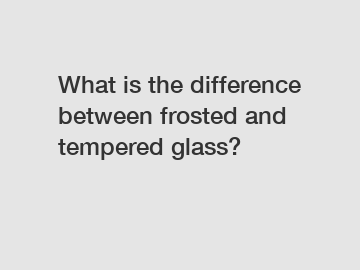What is the difference between frosted and tempered glass?
Glass is a versatile material that has a wide range of applications in various industries and everyday life. When it comes to glass for windows, doors, or other structures, two common types that are often compared are frosted glass and tempered glass. While both have their own unique characteristics and advantages, there are key differences between frosted glass and tempered glass that make each suitable for different purposes.
**Frosted Glass**.
Frosted glass is a type of glass that has been specially treated to give it a translucent appearance. This effect is achieved by either sandblasting or acid etching the surface of the glass, which creates a frosted or matte finish that scatters light rather than reflecting it. Frosted glass is popular for providing privacy while allowing light to pass through, making it an excellent choice for windows in bathrooms, offices, or partitions in commercial spaces.

One of the main advantages of frosted glass is its decorative appeal. The frosted finish adds a touch of elegance and sophistication to any space, while also diffusing light to create a soft, ambient glow. This makes frosted glass ideal for adding a stylish touch to doors, windows, or room dividers. Additionally, frosted glass is easy to clean and maintain, making it a practical choice for busy households or commercial settings.
**Tempered Glass**.
On the other hand, tempered glass is a type of safety glass that is processed through a series of heating and cooling treatments to increase its strength and durability. Tempered glass is up to five times stronger than regular glass and is designed to shatter into small, blunt pieces when broken, reducing the risk of injury. Due to its high strength and safety features, tempered glass is commonly used in applications that require a higher level of security, such as windows in high-traffic areas, glass doors, or shower enclosures.
One of the key advantages of tempered glass is its resistance to thermal stress and impact. Tempered glass can withstand sudden temperature changes without cracking or breaking, making it suitable for use in areas where extreme heat or cold may be a concern. Additionally, tempered glass is less likely to shatter on impact, providing added protection against accidents or break-ins.
**Key Differences**.
The primary difference between frosted glass and tempered glass lies in their characteristics and intended use. Frosted glass is primarily chosen for its decorative appeal and light diffusion properties, making it ideal for enhancing the aesthetics of a space while maintaining privacy. On the other hand, tempered glass is valued for its strength and safety features, making it a practical choice for applications that require durability and resistance to impact.
While frosted glass and tempered glass serve different purposes, they can also be combined to achieve both functionality and style in a space. For example, a glass shower enclosure made of tempered glass can feature frosted panels for added privacy without compromising on safety. By understanding the differences between frosted glass and tempered glass, you can make an informed decision when choosing the right type of glass for your needs.
In conclusion, frosted glass and tempered glass offer distinct benefits and characteristics that cater to different requirements. Whether you are looking for decorative appeal, privacy, durability, or safety, both types of glass have their own unique advantages. By considering your specific needs and preferences, you can select the type of glass that best suits your project. If you need further assistance or information on frosted glass and tempered glass, please feel free to contact us.
If you want to learn more, please visit our website what is tempered, silk screen advertising, ansi z97 1 standard.
115
0
0


Comments
All Comments (0)